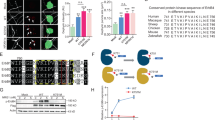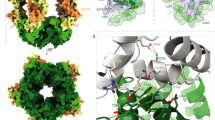Abstract
Synaptic adhesion molecules regulate multiple steps of synapse formation and maturation. The great diversity of neuronal synapses predicts the presence of a large number of adhesion molecules that control synapse formation through trans-synaptic and heterophilic adhesion. We identified a previously unknown trans-synaptic interaction between netrin-G ligand–3 (NGL-3), a postsynaptic density (PSD) 95–interacting postsynaptic adhesion molecule, and leukocyte common antigen-related (LAR), a receptor protein tyrosine phosphatase. NGL-3 and LAR expressed in heterologous cells induced pre- and postsynaptic differentiation in contacting axons and dendrites of cocultured rat hippocampal neurons, respectively. Neuronal overexpression of NGL-3 increased presynaptic contacts on dendrites of transfected neurons. Direct aggregation of NGL-3 on dendrites induced coclustering of excitatory postsynaptic proteins. Knockdown of NGL-3 reduced the number and function of excitatory synapses. Competitive inhibition by soluble LAR reduced NGL-3–induced presynaptic differentiation. These results suggest that the trans-synaptic adhesion between NGL-3 and LAR regulates excitatory synapse formation in a bidirectional manner.
This is a preview of subscription content, access via your institution
Access options
Subscribe to this journal
Receive 12 print issues and online access
$209.00 per year
only $17.42 per issue
Buy this article
- Purchase on Springer Link
- Instant access to full article PDF
Prices may be subject to local taxes which are calculated during checkout








Similar content being viewed by others
References
Yamagata, M., Sanes, J.R. & Weiner, J.A. Synaptic adhesion molecules. Curr. Opin. Cell Biol. 15, 621–632 (2003).
Dalva, M.B., McClelland, A.C. & Kayser, M.S. Cell adhesion molecules: signaling functions at the synapse. Nat. Rev. Neurosci. 8, 206–220 (2007).
Washbourne, P. et al. Cell adhesion molecules in synapse formation. J. Neurosci. 24, 9244–9249 (2004).
Akins, M.R. & Biederer, T. Cell-cell interactions in synaptogenesis. Curr. Opin. Neurobiol. 16, 83–89 (2006).
Craig, A.M. & Kang, Y. Neurexin-neuroligin signaling in synapse development. Curr. Opin. Neurobiol. 17, 43–52 (2007).
McAllister, A.K. Dynamic aspects of CNS synapse formation. Annu. Rev. Neurosci. 30, 425–450 (2007).
Ichtchenko, K. et al. Neuroligin 1: a splice site–specific ligand for beta-neurexins. Cell 81, 435–443 (1995).
Scheiffele, P., Fan, J., Choih, J., Fetter, R. & Serafini, T. Neuroligin expressed in non-neuronal cells triggers presynaptic development in contacting axons. Cell 101, 657–669 (2000).
Graf, E.R., Zhang, X., Jin, S.X., Linhoff, M.W. & Craig, A.M. Neurexins induce differentiation of GABA and glutamate postsynaptic specializations via neuroligins. Cell 119, 1013–1026 (2004).
Biederer, T. et al. SynCAM, a synaptic adhesion molecule that drives synapse assembly. Science 297, 1525–1531 (2002).
Fogel, A.I. et al. SynCAMs organize synapses through heterophilic adhesion. J. Neurosci. 27, 12516–12530 (2007).
Lin, J.C., Ho, W.H., Gurney, A. & Rosenthal, A. The netrin-G1 ligand NGL-1 promotes the outgrowth of thalamocortical axons. Nat. Neurosci. 6, 1270–1276 (2003).
Kim, S. et al. NGL family PSD-95–interacting adhesion molecules regulate excitatory synapse formation. Nat. Neurosci. 9, 1294–1301 (2006).
Kayser, M.S., McClelland, A.C., Hughes, E.G. & Dalva, M.B. Intracellular and trans-synaptic regulation of glutamatergic synaptogenesis by EphB receptors. J. Neurosci. 26, 12152–12164 (2006).
Boucard, A.A., Chubykin, A.A., Comoletti, D., Taylor, P. & Sudhof, T.C. A splice code for trans-synaptic cell adhesion mediated by binding of neuroligin 1 to alpha- and beta-neurexins. Neuron 48, 229–236 (2005).
Chih, B., Gollan, L. & Scheiffele, P. Alternative splicing controls selective trans-synaptic interactions of the neuroligin-neurexin complex. Neuron 51, 171–178 (2006).
Graf, E.R., Kang, Y., Hauner, A.M. & Craig, A.M. Structure function and splice site analysis of the synaptogenic activity of the neurexin-1 beta LNS domain. J. Neurosci. 26, 4256–4265 (2006).
Irie, M. et al. Binding of neuroligins to PSD-95. Science 277, 1511–1515 (1997).
Tabuchi, K. et al. A neuroligin-3 mutation implicated in autism increases inhibitory synaptic transmission in mice. Science 318, 71–76 (2007).
Jamain, S. et al. Reduced social interaction and ultrasonic communication in a mouse model of monogenic heritable autism. Proc. Natl. Acad. Sci. USA 105, 1710–1715 (2008).
Nakashiba, T. et al. Netrin-G1: a novel glycosyl phosphatidylinositol–linked mammalian netrin that is functionally divergent from classical netrins. J. Neurosci. 20, 6540–6550 (2000).
Nakashiba, T., Nishimura, S., Ikeda, T. & Itohara, S. Complementary expression and neurite outgrowth activity of netrin-G subfamily members. Mech. Dev. 111, 47–60 (2002).
Yin, Y., Miner, J.H. & Sanes, J.R. Laminets: laminin- and netrin-related genes expressed in distinct neuronal subsets. Mol. Cell. Neurosci. 19, 344–358 (2002).
Nishimura-Akiyoshi, S., Niimi, K., Nakashiba, T. & Itohara, S. Axonal netrin-Gs transneuronally determine lamina-specific subdendritic segments. Proc. Natl. Acad. Sci. USA 104, 14801–14806 (2007).
Zhang, W. et al. Netrin-G2 and netrin-G2 ligand are both required for normal auditory responsiveness. Genes Brain Behav. 7, 385–392 (2008).
Aoki-Suzuki, M. et al. A family-based association study and gene expression analyses of netrin-G1 and -G2 genes in schizophrenia. Biol. Psychiatry 57, 382–393 (2005).
Johnson, K.G. & Van Vactor, D. Receptor protein tyrosine phosphatases in nervous system development. Physiol. Rev. 83, 1–24 (2003).
Stryker, E. & Johnson, K.G. LAR, liprin alpha and the regulation of active zone morphogenesis. J. Cell Sci. 120, 3723–3728 (2007).
Serra-Pages, C. et al. The LAR transmembrane protein tyrosine phosphatase and a coiled-coil LAR-interacting protein colocalize at focal adhesions. EMBO J. 14, 2827–2838 (1995).
Kypta, R.M., Su, H. & Reichardt, L.F. Association between a transmembrane protein tyrosine phosphatase and the cadherin-catenin complex. J. Cell Biol. 134, 1519–1529 (1996).
Zhen, M. & Jin, Y. The liprin protein SYD-2 regulates the differentiation of presynaptic termini in C. elegans. Nature 401, 371–375 (1999).
Kaufmann, N., DeProto, J., Ranjan, R., Wan, H. & Van Vactor, D. Drosophila liprin-alpha and the receptor phosphatase Dlar control synapse morphogenesis. Neuron 34, 27–38 (2002).
Ackley, B.D. et al. The two isoforms of the Caenorhabditis elegans leukocyte-common antigen related receptor tyrosine phosphatase PTP-3 function independently in axon guidance and synapse formation. J. Neurosci. 25, 7517–7528 (2005).
Dunah, A.W. et al. LAR receptor protein tyrosine phosphatases in the development and maintenance of excitatory synapses. Nat. Neurosci. 8, 458–467 (2005).
O'Grady, P., Thai, T.C. & Saito, H. The laminin-nidogen complex is a ligand for a specific splice isoform of the transmembrane protein tyrosine phosphatase LAR. J. Cell Biol. 141, 1675–1684 (1998).
Johnson, K.G. et al. The HSPGs Syndecan and Dallylike bind the receptor phosphatase LAR and exert distinct effects on synaptic development. Neuron 49, 517–531 (2006).
Fox, A.N. & Zinn, K. The heparan sulfate proteoglycan syndecan is an in vivo ligand for the Drosophila LAR receptor tyrosine phosphatase. Curr. Biol. 15, 1701–1711 (2005).
Yang, T. et al. Leukocyte antigen-related protein tyrosine phosphatase receptor: a small ectodomain isoform functions as a homophilic ligand and promotes neurite outgrowth. J. Neurosci. 23, 3353–3363 (2003).
Biederer, T. & Scheiffele, P. Mixed-culture assays for analyzing neuronal synapse formation. Nat. Protoc. 2, 670–676 (2007).
Ko, J. et al. SALM synaptic cell adhesion–like molecules regulate the differentiation of excitatory synapses. Neuron 50, 233–245 (2006).
Zhang, J.S., Honkaniemi, J., Yang, T., Yeo, T.T. & Longo, F.M. LAR tyrosine phosphatase receptor: a developmental isoform is present in neurites and growth cones and its expression is regional- and cell-specific. Mol. Cell. Neurosci. 10, 271–286 (1998).
Pulido, R., Serra-Pages, C., Tang, M. & Streuli, M. The LAR/PTP delta/PTP sigma subfamily of transmembrane protein-tyrosine- phosphatases: multiple human LAR, PTP delta and PTP sigma isoforms are expressed in a tissue-specific manner and associate with the LAR- interacting protein LIP.1. Proc. Natl. Acad. Sci. USA 92, 11686–11690 (1995).
O'Grady, P., Krueger, N.X., Streuli, M. & Saito, H. Genomic organization of the human LAR protein tyrosine phosphatase gene and alternative splicing in the extracellular fibronectin type-III domains. J. Biol. Chem. 269, 25193–25199 (1994).
Zhang, J.S. & Longo, F.M. LAR tyrosine phosphatase receptor: alternative splicing is preferential to the nervous system, coordinated with cell growth and generates novel isoforms containing extensive CAG repeats. J. Cell Biol. 128, 415–431 (1995).
Patel, M.R. et al. Hierarchical assembly of presynaptic components in defined C. elegans synapses. Nat. Neurosci. 9, 1488–1498 (2006).
Dai, Y. et al. SYD-2 Liprin-alpha organizes presynaptic active zone formation through ELKS. Nat. Neurosci. 9, 1479–1487 (2006).
Bamji, S.X. et al. Role of beta-catenin in synaptic vesicle localization and presynaptic assembly. Neuron 40, 719–731 (2003).
Bamji, S.X., Rico, B., Kimes, N. & Reichardt, L.F. BDNF mobilizes synaptic vesicles and enhances synapse formation by disrupting cadherin-beta-catenin interactions. J. Cell Biol. 174, 289–299 (2006).
Majeti, R. & Weiss, A. Regulatory mechanisms for receptor protein tyrosine phosphatases. Chem. Rev. 101, 2441–2448 (2001).
Nam, H.J., Poy, F., Krueger, N.X., Saito, H. & Frederick, C.A. Crystal structure of the tandem phosphatase domains of RPTP LAR. Cell 97, 449–457 (1999).
Acknowledgements
We would like to thank A.M. Craig for neurexin 1α, 2α, 3α and 1β cDNAs, T. Biederer for SynCAM 1, Y.-P. Hsueh for Syndecan-2, P. Maness for NCAM-140, J. Ko for quantitative analysis, J. Nam for SALM4, M.-H. Kim for the mini analysis program, and Y.-G. Oh, M.-S. Baek, M. Ryu and J.-G. Jung for the help with antibody generation. This work was supported by the National Creative Research Initiative Program of the Korean Ministry of Science and Technology (E.K.).
Author information
Authors and Affiliations
Contributions
J.W. and S.-K.K. carried out the experiments, analyzed the data and wrote the manuscript. S.C. helped with the shRNA knockdown experiments. S.K., J.-R.L., A.W.D. and M.S. contributed reagents. E.K. supervised the project and wrote the manuscript. All authors discussed the results and commented on the manuscript.
Corresponding author
Supplementary information
Supplementary Text and Figures
Supplementary Figures 1–10 and Supplementary Methods (PDF 5340 kb)
Rights and permissions
About this article
Cite this article
Woo, J., Kwon, SK., Choi, S. et al. Trans-synaptic adhesion between NGL-3 and LAR regulates the formation of excitatory synapses. Nat Neurosci 12, 428–437 (2009). https://doi.org/10.1038/nn.2279
Received:
Accepted:
Published:
Issue Date:
DOI: https://doi.org/10.1038/nn.2279
This article is cited by
-
Liprin-α proteins are master regulators of human presynapse assembly
Nature Neuroscience (2024)
-
Molecular subtypes based on PANoptosis-related genes and tumor microenvironment infiltration characteristics in lower-grade glioma
Functional & Integrative Genomics (2023)
-
Finding New Ways How to Control BACE1
The Journal of Membrane Biology (2022)
-
Leucine-rich repeat containing 4 act as an autophagy inhibitor that restores sensitivity of glioblastoma to temozolomide
Oncogene (2020)
-
Structural insights into selective interaction between type IIa receptor protein tyrosine phosphatases and Liprin-α
Nature Communications (2020)



